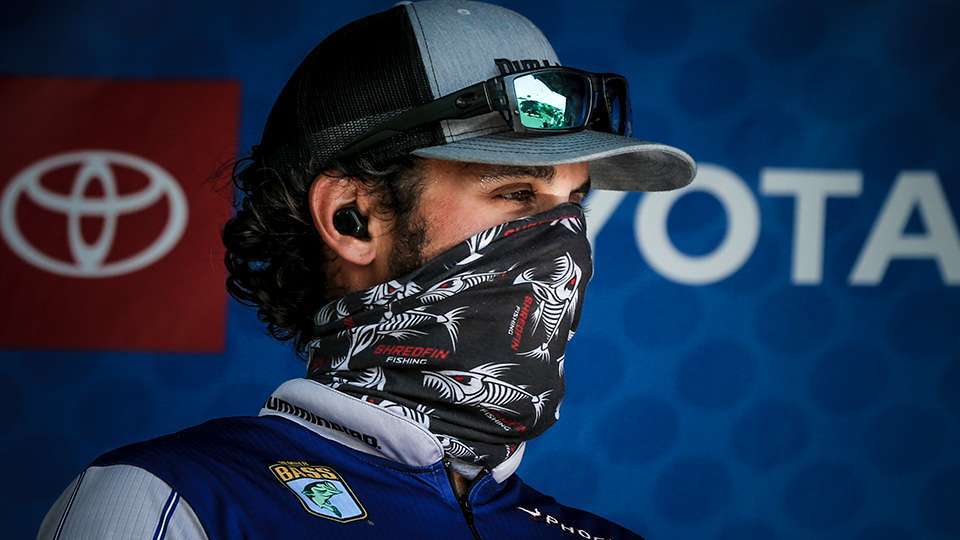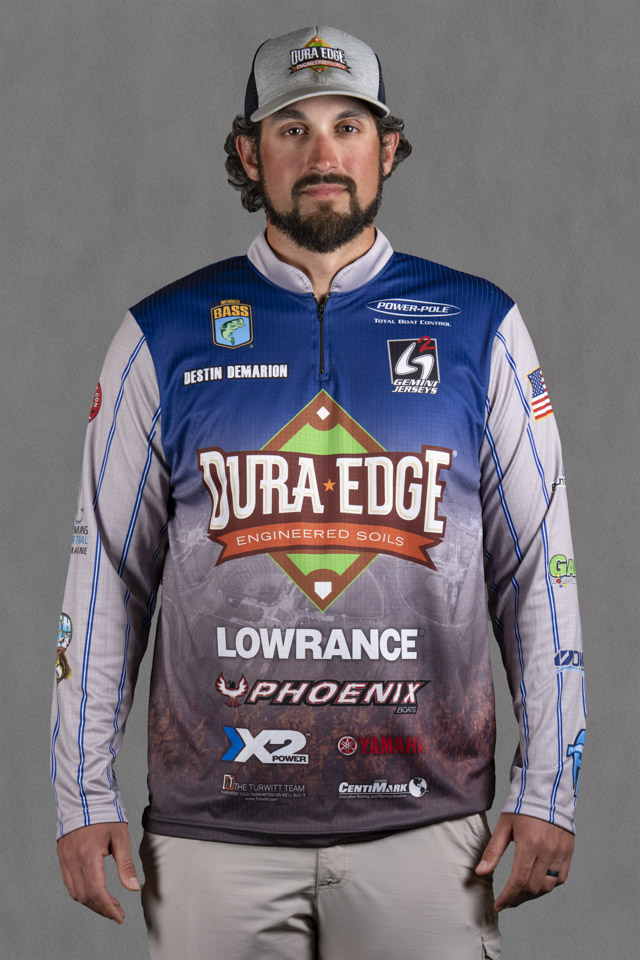
Coming into this fall swing of our Bassmaster Elite Series season, we were in uncharted waters. Due to the pandemic, many of our spring events were rescheduled to the fall months, which was definitely new for B.A.S.S. and most of the field. Considering the circumstances, I was excited just to get a full season. B.A.S.S. did a tremendous job keeping our season intact and working around the many hurdles we now have to deal with to make this happen.
Lake Guntersville
We kicked off our fall swing on the Tennessee River at the famous grass-filled waters of Lake Guntersville, Alabama. This event definitely hit at that early fall transition time when things are constantly in flux. The water levels of the lake are adjusted heading towards winter, and the fish are adapting and following the schools of bait in their seasonal migrations. You saw a little bit of everything in this one as guys were fishing bridges, docks, laydowns, main river bars and backs of creeks. Fish were scattered nearly everywhere.
I practiced just about everything, and the best thing I had going was the back of a major creek and some main river grass patches where I was punching and frogging.
Day 1 of the tournament, I started in the back of a creek where I found the most bites. I had shaken about a dozen bites off in practice on a buzzbait and frog. In these events where bites are at a premium. I really think shaking off, or not hooking fish in practice, is extra important. The water temperature had dropped significantly, and I only managed to put one keeper in the livewell. I caught it on a buzzbait before making the adjustment to the flipping stick. I headed out to my best punching stretches and exactly where I had shaken one off the day before, I caught my biggest fish of the day, a 4-pounder, punching through some matted main river grass. I’m not really a puncher, but the conditions made me feel it was the right thing to do with high pressure that day. I bounced around to a few of my best stretches and put a solid limit in the boat to start out the event in 29th.
Day 2, the conditions were similar, and I felt the same routine could be equally productive. However, after missing a couple of half-hearted frog bites and only catching shorts punching, I began running some docks and fishing some bars before heading into the back of my best creek. But, I was only able to muster up a couple more short bites and ended the day with only one fish to add. It was somewhat frustrating, but after a debrief following the event, I learned some important lessons for the next time, if ever, we head back to Guntersville in the fall.
Santee Cooper Lakes
Next up were the Santee Cooper Lakes in South Carolina, which are made up of Lake Marion, where we launched each day, and Lake Moultrie, the lower lake. After stumbling Day 2 at Guntersville, I came in with the mindset to shake it off and go back to work. I’ve found the best thing you can do following a tough event is to process it, let it go in 24 hours and literally do nothing but go back and work just as hard in practice for the next.
Coming in, I didn’t have experience on these vast and treacherous bodies of water. The two things I did know were, the fish of a lifetime is never too far away at Santee and that these stump-filled waters have eaten more lower units and props over the years than just about any other fishery. An equal amount of excitement and terror for my safety and pocketbook would be a safe assessment of how I felt going in. I ended up spending 95% of my practice in possibly the most dangerous area, above the I-95 bridge on Lake Marion, known as “The Swamp.” This area offers a lot of things that are key: current (with the Congaree River), vegetation and an untold amount of cypress trees and wood cover to fish. While these all add up to being excellent ingredients for healthy populations of bass, the sheer amount of fishable water can be overwhelming. Not really knowing much, I just decided to focus on the river portion with lowfalls and stumphole areas. I got a good amount of bites in practice, but once again shook most off wanting to conserve them for the event. So, I didn’t really know how big many were.
Day 1, I mostly spent my time in the river before adjusting to the forest, stumphole area where I had the most bites. I was able to put a decent limit together fairly quickly flipping then catching my biggest fish on a crankbait up the river on a spot I shook it off the day before.
Twelve pounds had me right at the cut line, and Day 2 I decided I was going to focus more on the stumphole area. After flipping some, with the change in conditions to more cloud cover, I picked up a B Hite Delite Jackhammer ChatterBait with a Berkley The Deal trailer in Electric Shad. This was truly “The Deal” when fishing around so many others throwing similar presentations. I caught one on my second cast and didn’t look back to the tune of 16 pounds, then 18 pounds on Day 3. I also ripped my pants once again — it has to be good luck or something. I made my first Championship Sunday in my rookie Elite Series season. I drove three hours round trip to Pure Fishing Headquarters in Columbia, S.C., to get more of this key bait after running out of them.
Day 4, the bite dwindled despite working the area even harder with less pressure from other boats. Despite losing a couple of key fish, it didn’t really end up mattering as Brandon Palaniuk closed the door catching a monster bag to close out the win. It was an amazing experience as it was truly the first big crowd we had since the St. John’s event due to COVID restrictions.
Lake Chickamauga
For the third week, we headed to my favorite bass fishery in the country, Lake Chickamauga in Tennessee. After seeing recent tournament results there, I knew it would be nothing like the times I had been there in the spring. The water levels had been fluctuating up and down, making the fish a bit less comfortable, resulting in some tough conditions.
In practice I tried to build off what I had learned at Guntersville, but I quickly learned it was a different animal. I had five bites the first day of practice, seven on day two and only one the final day leading me to believe something was changing significantly. Nevertheless, I figured despite the tough fishing conditions, mustering 8 to 10 pounds was doable with an opportunity for more. Nearly every grass bed on the lake held some bass. You could see them busting every now and again, but they were extremely hard to get to bite with the abundance of small baitfish they were keying on.
Day 1 I started on two isolated grass mats and produced three bites on a buzzbait, popper and frog, none of which got in the boat. Another two bites came on a spinnerbait which somehow skirted getting hooked and the lone keeper of the day came on a brown jig. I mainly fished a section of the lake that I have had success on in the past and hit mats, scattered grass bars, pockets, docks, laydowns, rip rap and just about anything that looked good with nothing to show.
Day 2 went much the same but overall with less keeper bites and more shorts. I did end up catching my only keeper on that ChatterBait combo used at Santee, but again I was only able to bring one keeper to the scales. It was a bit of a head-scratcher for me. Outside of the spawn/postspawn time period, the Tennessee River has been a tough nut to crack for me.
Driving 10 hours home gives you plenty of time to think. Every tournament, no matter how well or how poorly you do, there is always a lesson to be learned and room to grow for the next time. That’s something I’ve taken since my time fishing as a co-angler. I saw many co-anglers complain about bad draws over the years, and I really tried to adopt the mindset that there was not such a thing. That may seem a bit warped, but the fact of the matter is your mind dictates so much of your experience.
People love to complain all the time about other people, circumstances and variables outside our control — I’m no better as there have been times in my life that I’ve fallen into this trap too. But, every time you go fishing, regardless of the outcome, if you catch 20 pounds or zero, the way you react ultimately dictates what kind of experience it is or was.
Some of my best tournaments weren’t necessarily surrounded by objectively the best circumstances, but truly I don’t lament any of them as they are all part of the experience. I don’t dwell on the pain of lost fish and coulda, shoulda or woulda at this point in my career. It’s never productive. Gratitude for having the opportunities you have is the most useful thing I have found. Even if those opportunities don’t end up the way you would like them every time, it always works out for the best regardless if we can see it at the time or not.
On side note, I wanted to congratulate Frank Talley, Brandon Palaniuk and Lee Livesay on well-earned wins on some challenging fall fisheries. Two first-time Elite Series winners and another big win on a successful veteran’s resume were pretty cool to see.
The thing I love about the Elite Series is the fact that there is almost an entire field of anglers that have the ability to win any given event. You’ve seen a number of first-time winners this season, and I think you will continue to see this trend in upcoming years. I’m blessed to be where I am, and I’m thankful to have such great competition on the Bassmaster Elite Series that drives me to get better everyday.

